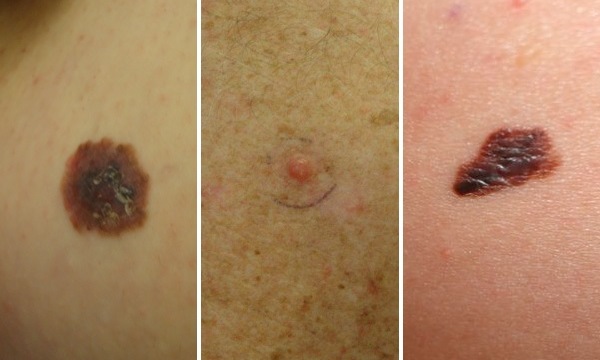
By now we’re all aware of the risks of sun exposure. In honor of Skin Cancer Awareness Month, we’re shedding some light on melanoma, which is the most dangerous form of skin cancer. Read on to learn about melanoma, how to tell if a mole is cancerous and what you can do to protect yourself.
1. What is melanoma?
Melanomas often resemble moles and some even start from moles. The majority of these moles are black or brown, but they can also appear as pink, red, purple, blue or white in color. This deadly form of skin cancer kills an estimated 9,940 people in the United States each year, according to the Skin Cancer Foundation. Additionally, the American Cancer Society estimates that more than 135,000 new cases of melanoma in the U.S. are diagnosed annually.
If melanoma is diagnosed and treated in its early stages, it is almost always curable. If it’s not caught early, melanoma can spread to other parts of the body, where it becomes hard to treat and can be fatal.
2. Who is at risk for melanoma?
Everyone is at risk for melanoma, but increased risk depends on several factors including sun exposure, number of moles on the skin, skin type and family history. Those with fair skin, lighter hair and lighter eye color have a higher risk of developing melanoma. Anyone who has 50 or more moles, large moles or unusual looking moles is also at risk. Melanoma is more common in those who’ve had blistering sunburns in early childhood, but sunburns later in life also pose a threat.
Tanning beds emit ultraviolet radiation that is two to three times stronger than the sun at its peak, raising your risk of developing melanoma and other skin cancers. In fact, indoor tanning increases a person's melanoma risk by 75 percent, according to the American Academy of Dermatology.
3. How to tell if a mole is cancerous
Self-examination is essential to catching melanoma in its early stages. A change in a mole or growth is generally the first sign of skin cancer. Moles that change, itch, bleed or don't heal are also warning signs. Learn how to spot melanoma with the three examples below:

Examine your skin from head to toe at least once a month, looking for areas of concern. You can examine your moles and birthmarks using the ABCDE rule, which can help spot the early signs of melanoma:
- Asymmetry
- Borders with irregular edges
- Color is varied from one area to another
- Diameter is larger than a pencil eraser
- Evolving over time, changing in size, shape or color
You can also use the Ugly Duckling method, which is based on the concept that melanoma appears different than surrounding moles. Normal moles resemble each other while melanoma looks or feels different. Another sign could be that over time the melanoma changes differently than the other moles in the same area.
When examining your skin, be sure to check your scalp, feet, palms, nails, and genital area. With the rise of tanning bed use, melanoma is becoming more common in unexpected places that aren’t usually exposed to the sun.
If you find a mole that is growing in size, unusual, bleeding, irritated or different from the rest of your moles, it’s time to see a board-certified dermatologist. Self-examination is useful, but any areas of concern should always be checked by a professional. Additionally, it’s important to see a dermatologist at least once a year for a full skin check.
4. Treatment for melanoma
Your dermatologist will perform a biopsy to remove any suspicious-looking moles and they will be sent to a lab for further testing. Melanoma cannot be diagnosed without a biopsy. This is often done with a shave biopsy, which involves using a tool to shave or scrape abnormalities off the skin’s surface.
If melanoma is detected, your dermatologist will perform a procedure to remove any tissue where cancer cells are present. This is sometimes done through Mohs Micrographic Surgery, a procedure where a thin layer of tissue containing the melanoma is removed, examined under a microscope and mapped in detail. This mapping allows your dermatologist to determine exactly where cancer cells are present. Thin layers of tissue are gradually removed until no cancer cells are found. This technique allows for most of the healthy tissue to remain intact, and it has an impressive 99 percent or better success rate.
Once you have had melanoma, you are five times more likely to have a recurrence. Those who have had other forms of skin cancer are also at increased risk for developing melanoma. For this reason, it is essential to keep all follow-up appointments with your dermatologist. You should also see your dermatologist for annual skin checkups and perform your own self-examinations between these appointments.
5. How to protect yourself from skin cancer
Practicing sun safety will help protect your skin from melanoma and other forms of skin cancer. Always wear a broad spectrum sunscreen with an SPF of 30 or more every day, even when the sun isn’t shining. Avoid spending time outdoors between 10 a.m. and 4 p.m. when the sun is at its peak, and always seek shade. If you’re playing sports outside, choose a water-resistant sunscreen with a high SPF, and reapply often. Sun protective clothing like long sleeves, long pants, sunglasses and wide-brimmed hats can provide additional protection from the sun.
Do you have questions about how to spot melanoma or treatment for melanoma? Share with us in the comments below.

About the Author
Kristen is a copy editor for LovelySkin who loves catching up on the latest in skin care and beauty trends. Her favorite things include cats, concerts and Harry Potter.
Other Posts by KristenA Healthy Scalp Encourages Healthier Hai...
Learn about Skin-Healthy, Strawberry-Ins...
Follow us on social
Follow us on social networks and be one of the first to learn about sales, giveaways, and free samples






